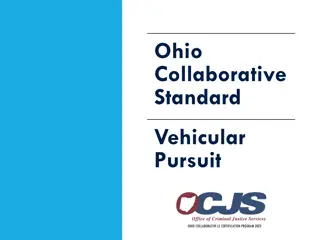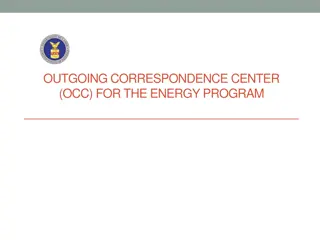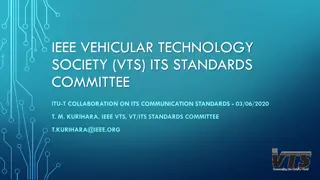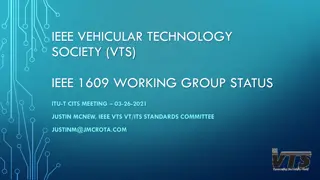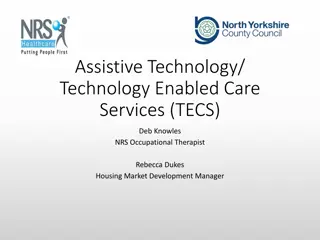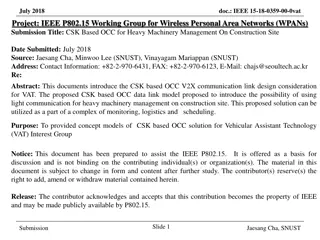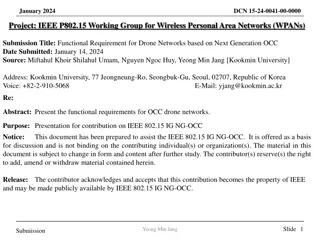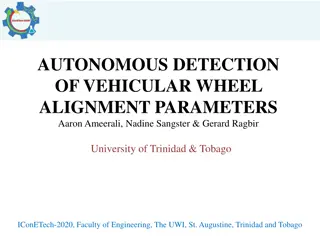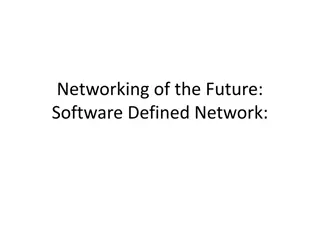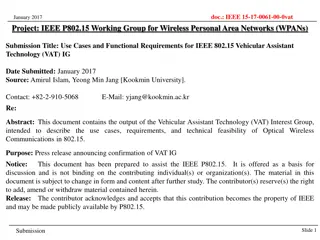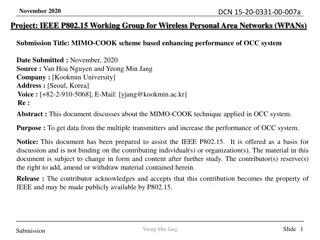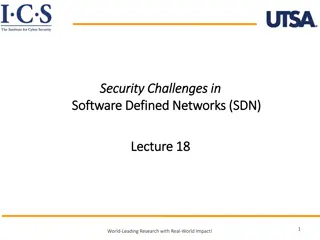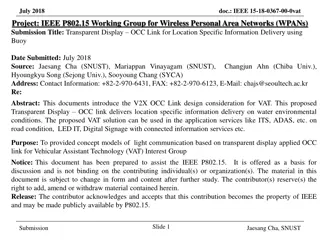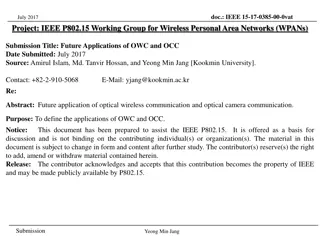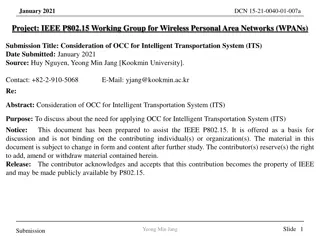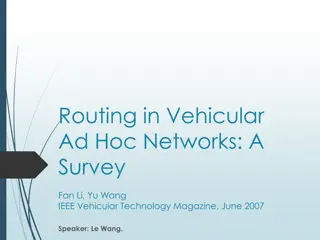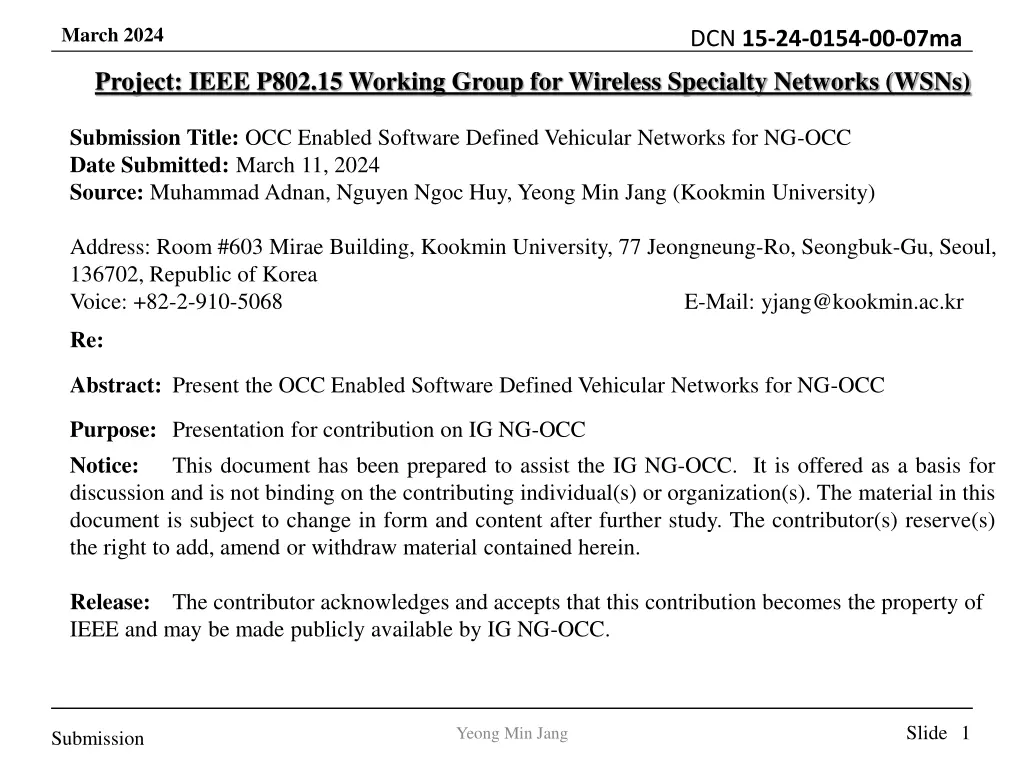
OCC-Enabled Software Defined Vehicular Networks: Next-Gen Architecture
Explore the innovative OCC-enabled Software Defined Vehicular Networks for NG-OCC, integrating OCC technology with vehicular ad-hoc networks and software-defined principles for efficient resource management. Learn about the architecture components, including OCC Infrastructure and Vehicle Cameras, enhancing V2V and V2I communication in IoV environments.
Download Presentation

Please find below an Image/Link to download the presentation.
The content on the website is provided AS IS for your information and personal use only. It may not be sold, licensed, or shared on other websites without obtaining consent from the author. If you encounter any issues during the download, it is possible that the publisher has removed the file from their server.
You are allowed to download the files provided on this website for personal or commercial use, subject to the condition that they are used lawfully. All files are the property of their respective owners.
The content on the website is provided AS IS for your information and personal use only. It may not be sold, licensed, or shared on other websites without obtaining consent from the author.
E N D
Presentation Transcript
March 2024 DCN 15-24-0154-00-07ma Project: IEEE P802.15 Working Group for Wireless Specialty Networks (WSNs) Submission Title: OCC Enabled Software Defined Vehicular Networks for NG-OCC Date Submitted: March 11, 2024 Source: Muhammad Adnan, Nguyen Ngoc Huy, Yeong Min Jang (Kookmin University) Address: Room #603 Mirae Building, Kookmin University, 77 Jeongneung-Ro, Seongbuk-Gu, Seoul, 136702, Republic of Korea Voice: +82-2-910-5068 E-Mail: yjang@kookmin.ac.kr Re: Abstract: Present the OCC Enabled Software Defined Vehicular Networks for NG-OCC Purpose: Presentation for contribution on IG NG-OCC Notice: This document has been prepared to assist the IG NG-OCC. It is offered as a basis for discussion and is not binding on the contributing individual(s) or organization(s). The material in this document is subject to change in form and content after further study. The contributor(s) reserve(s) the right to add, amend or withdraw material contained herein. Release: The contributor acknowledges and accepts that this contribution becomes the property of IEEE and may be made publicly available by IG NG-OCC. Slide 1 Yeong Min Jang Submission
March 2024 DCN 15-24-0154-00-07ma OCC Enabled Software Defined Vehicular Networks for NG-OCC March 11, 2024 Slide 2 Yeong Min Jang Submission
March 2024 DCN 15-24-0154-00-07ma Contents Background OCC Based IoV OCC Enabled Software Defined Vehicular Networks for NG-OCC Conclusion Slide 3 Yeong Min Jang Submission
March 2024 DCN 15-24-0154-00-07ma Background: OCC Based IoV An overview of OCC-based IoV architecture is proposed in [1], where the combination of the cloud and the vehicular communication system uses OCC for V2V and V2I communication to exchange information about the fundamental status of the vehicle and event-triggered notifications of emergencies to distribute the necessary information environment. Four different forms of communication are included in their proposed architecture: OCC- based V2V and V2I communication and Wi-Fi or cellular-based V2C and I2C communication. The bottom layer of Fig. 1 shows the vehicular communication mechanism using OCC for V2V and V2I communication uses vehicle backlight LED lights (Tx) and a camera (webcam or high-speed camera) as Rx. Tx transmits vehicle status or traffic conditions, while Rx receives information from image sensors. Forward vehicles transmit information through LEDs, while following vehicles receive it using a camera. Traffic lights also transmit data. in a real-time Fig.1:OCC-based IoV architecture Slide 4 Yeong Min Jang Submission
March 2024 OCC Enabled Software Defined Vehicular Networks for NG-OCC DCN 15-24-0154-00-07ma Designing a next-generation OCC-based SDVN architecture involves integrating OCC technology with vehicular ad-hoc network concepts and leveraging software-defined principles for efficient resource management. Architecture Components: OCC Infrastructure: This includes LED lights installed on vehicles or roadside infrastructure for data transmission. Vehicle Cameras: Vehiclea are equipped with cameras capable of capturing optical signals from other vehicles or infrastructure. Software-Defined IoV Module: The SDN controller is responsible for managing communication resources, routing, and optimizing data transmission. Cloud or Edge Computing: Processing and analyzing data collected from OCC-enabled vehicles to provide actionable insights and services. Design Considerations: Inter-Vehicle Communication: OCC uses vehicle backlight LED lights or traffic lights as Tx and camera (webcam or high-speed camera) as Rx. The Tx (traffic light or vehicles rear LEDs) transmit the vehicles status or the traffic condition. Then, the receiver can be a single or pair of image sensor which receives the transmitted information from the Tx. Fig.1:OCC-based IoV architecture Slide 5 Yeong Min Jang Submission
March 2024 DCN 15-24-0154-00-07ma Continue... Design Considerations: Infrastructure Integration: In Vehicle to Infrastructure (V2I) communications, messages from the networks to the vehicles are transported over the links between traffic lights and cameras mounted on the vehicles, while data is transmitted from the headlights and taillights of vehicles to roadside networking infrastructures through traffic cameras intended to monitor such light sources. Through the use of cellular technology, Vehicle to Cloud (V2C) allows both forwarding and following vehicles to exchange information with a cloud server. Software-Defined Management: The SDN controller enable dynamic allocation and optimization of communication resources, ensuring efficient IoV operations. Slide 6 Yeong Min Jang Submission
March 2024 DCN 15-24-0154-00-07ma Conclusion The main features of SDN, like flexibility, programmability, and centralized control, make the network s design and deployment scalable and straightforward. The SDN controller builds a global view of the communication infrastructure and distributes its policy rules. The SDN controller has a clear scope for the state of the entire network. The next-generation OCC-based Software-Defined Vehicular Network (SDVN) architecture offers significant benefits in terms of QoS in traffic management, efficiency, connectivity, safety and data-driven insights. By integrating OCC technology with IoV concepts and leveraging software-defined principles, we can enable innovative applications and services that enhance the overall transportation ecosystem. Slide 7 Yeong Min Jang Submission
March 2024 DCN 15-24-0154-00-07ma Reference [1] Hasan, M. K., Ali, M. O., Rahman, M. H., Chowdhury, M. Z., & Jang, Y. M. (2021). Optical camera communication in vehicular applications: A review. IEEE transactions on intelligent transportation systems, 23(7), 6260-6281. Slide 8 Yeong Min Jang Submission

